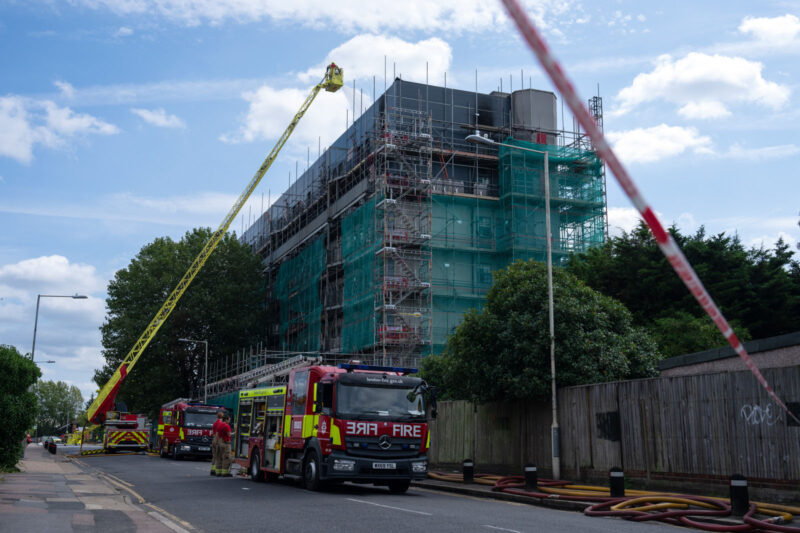‘We feel suffocated’: the homes that are becoming uninhabitable in heat
Muslim and minority communities are likely to be most affected by rising temperatures as extreme heat exposes failings in the UK’s housing stock
–

At the top of five flights of concrete stairs, Asma opens her front door to sweat-inducing heat. She lives in a five-storey social housing block, inaccessible by lift, that looks over the suburban desert of Lordshill, a Southampton neighbourhood filled with grey rows of terraced homes.
Asma — who asked to remain anonymous out of fear of reprisals from Southampton city council, her landlord — shares a three-bedroom flat with three of her four children. The cool air outside does nothing to deter the sweltering temperatures indoors, locked in by windows that open enough to invite in the odour of her neighbours’ marijuana, though not enough for the breeze.
“We can’t breathe, we feel suffocated,” Asma whispers in Urdu. “It’s really affecting me, and my kids are under so much stress.”
Her 16-year-old daughter is disabled, and her condition makes her more at risk of heat stress.
“They always ask, why can’t we move to a proper house, Mama? I try to tell them things will get better. But I know they won’t. And they know I can’t keep my promise,” Asma tells Hyphen.
New research has shown that 4.5 million people have become ill as a result of homes being too hot owing to the country’s poor housing stock. And as our planet warms, millions are likely to be affected by homes unable to cope with the heat.
The analysis from Warm This Winter, released in August, also found that people from Asian, Black and minority ethnic backgrounds are most likely to experience heat-related ill health for reasons such as social and economic disparities. As a third of Muslims live in the most deprived areas in the UK, they are vulnerable to the impacts of overheating as the climate crisis worsens. What’s more, people of colour are four times more likely to live in areas most exposed to extreme heat.
Southampton was ranked by Friends of the Earth and the University of Manchester as one of the areas outside of the capital most vulnerable to the impacts of extreme hot weather in the UK, even if the world reaches the United Nations’ target of limiting global warming to 1.5C. In June 2022, the city recorded its highest-ever temperature, at 35.6C.
The consequences of living in extreme heat are severe: last year alone, nearly 2,300 heat-related deaths were reported across the country.
In Asma’s flat, a child safety lock means the windows cannot be fully opened. Sara Saadouni, an academic at Nottingham Trent University and architect specialising in sustainability, says this is like being “trapped in a box”.
“The mechanical systems that are potentially installed in the block aren’t designed to deal with these issues,” she says. “Traditionally in temperate climates like the UK, buildings are made to optimise heat rather than cooling. But natural ventilation isn’t an option here, due to the pollution.”
Saadouni adds that upgrading the window and ventilation systems inside the block could help manage the temperatures, but she points to a larger issue: “The problem that we’re facing as a country is that we have a building stock that needs a lot of upgrading and needs a lot of money to be invested in it. And nobody’s investing in that.”
According to Emily Morrison, head of sustainability and just transition at the Young Foundation, overheating is a problem across “all social housing” in the UK.
“Fifty-five per cent of homes in the UK don’t meet the minimum bedroom standard and they overheat beyond 26 degrees in the current conditions,” she says. “Of that, around 40% of dwellings may be uncomfortably warm in summer, so it’s very widespread. Then if we break it down, disproportionately, a larger number of these are related to flats, partly because of the constructs.”
Morrison adds that social housing is particularly vulnerable to overheating because people on lower incomes are more likely to have long-term health conditions. At the same time, they have less agency to make changes to their homes.
Research has shown that dense, concrete areas such as Asma’s local authority housing estate are substantially hotter than those with trees and vegetation, as buildings and cement hold on to heat because of an occurrence known as the heat island effect. Neighbourhoods like hers are “three to four degrees hotter than the countryside” because of a “greenhouse-like effect”, Saadouni adds.
A Southampton city council spokesperson told Hyphen the council’s “domestic portfolio investment programme has been developed to target improvement of the energy performance of our housing stock. Over the next five years, the total planned investment on energy efficiency alone is in excess of £25 million.”
Yet the issue of addressing the risk of overheating in existing homes and buildings has still not been addressed by central government, experts say. “The UK is not adequately prepared for the impacts of climate change,” says Gemma Holmes, senior analyst in adaptation at the Climate Change Committee. “Overheating in buildings caused by higher temperatures and more intense heatwaves is increasing the risk to people. The UK needs to upgrade existing buildings to limit the impact of overheating and ensure building regulations for new buildings are appropriately implemented.”
A spokesperson from the Department for Environmental and Rural Affairs said: “The new government will ensure that the UK is prepared for these changes by strengthening resilience across government and local communities.” They did not outline any specific steps the government is taking to ensure that people’s homes are fit for habitation as temperatures continue to rise.
Yet, this lack of action is simply exacerbating social inequalities, according to Mike Childs, head of science, policy and research at Friends of the Earth. “Climate change already disproportionately impacts marginalised communities who are often most affected by extreme heat but lack the financial means to adapt their homes to cope.”
In the St Mary’s neighbourhood of Southampton, Saima, a mother of two, has become worn down by sleepless nights throughout the summer: “I wish family or friends could come over but there’s no use in this weather. It’d be like a greenhouse. I know there are so many activities outside but the cost of everything nowadays is so expensive. So we stay home, but it gets lonely and we need our community.”
Inspired by her elders in Pakistan, Saima has attempted to take matters into her own hands through creating a DIY cooling unit, by placing a bucket of ice in front of one of the three fans occupying the lounge in her council home.
The use of ice buckets for cooling, as Saima has done, is not uncommon. Morrison warns against people taking DIY measures into their own hands for safety reasons, but she is sympathetic about the lack of choice many face.
“One of the key problems, particularly for social housing tenants, is the lack of agency over processes like retrofit,” she says, adding that a lot of these issues could be addressed through a light-tough retrofit such as installing shutters or blinds.
“Overheating creates unmanageable costs through trying to cool their homes so it places a disproportionate burden on the social housing tenants through needing to buy fans, which is one of the biggest, most costly ways of using electricity,” Morrison adds.
She describes it as a “poverty premium”, where households effectively “get poorer due to having a limited number of mitigation measures that they can adopt for overheating”.
For the moment, many tenants feel like they are left alone to come up with makeshift solutions. “I’ve tried contacting the council so many times to switch homes and it goes nowhere. I can’t change the windows or walls of where I live,” Asma says. “We feel like we’re on our own and there’s no one out there looking out for us.”
 Newsletter
Newsletter












